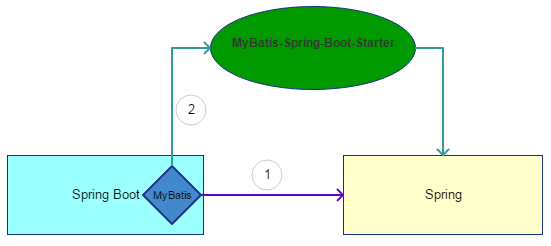SpringBoot标准集成MyBatis的2种方式是怎样的,针对这个问题,这篇文章详细介绍了相对应的分析和解答,希望可以帮助更多想解决这个问题的小伙伴找到更简单易行的方法。
最近很多人Spring Boot中使用MyBatis时遇到的问题,大多数问题总结起来就是对MyBatis和Spring框架不熟悉的原因导致的。实际上,在Spring Boot中使用MyBatis本质就是在Spring框架中集成MyBatis,并没有其他任何高级的东西。只不过在Spring Boot中使用时因为插件封装的关系使得相关的配置可以更简洁一些,但是这种封装对于不熟悉MyBatis的人来讲反而增加了理解的难度。因此,我想把如何在Spring Boot中使用MyBatis进行一个系统性的总结,希望能有一些参考价值。
使用任何数据库服务器,只要是使用JDBC方式连接,都需要添加数据库驱动,甚至还需要添加数据库连接池依赖,如下配置以添加MySQL驱动为例进行说明。
<!-- 添加MySQL数据库驱动 -->
<dependency>
<groupId>mysql</groupId>
<artifactId>mysql-connector-java</artifactId>
</dependency>
<!-- 添加数据库连接池 -->
<dependency>
<groupId>com.alibaba</groupId>
<artifactId>druid</artifactId>
<version>${version.druid}</version>
</dependency>
在使用数据库之前先要在Spring Boot中配置数据源,如下所示:
spring:
datasource:
name: testDatasource
driver-class-name: com.mysql.jdbc.Driver
url: jdbc:mysql://127.0.0.1:3306/test_springboot
username: root
password:
当然,还可以配置数据库连接池:
#datasource
spring:
datasource:
name: testDatasource
driver-class-name: com.mysql.jdbc.Driver
url: jdbc:mysql://127.0.0.1:3306/test_springboot
username: root
password:
# 使用druid连接池
type: com.alibaba.druid.pool.DruidDataSource
filters: stat
maxActive: 20
initialSize: 1
maxWait: 60000
minIdle: 1
timeBetweenEvictionRunsMillis: 60000
minEvictableIdleTimeMillis: 300000
validationQuery: select 'x'
testWhileIdle: true
testOnBorrow: false
testOnReturn: false
poolPreparedStatements: true
maxOpenPreparedStatements: 20
这种集成方式本质上就是在Spring框架中集成MyBatis的方式,所以在非Spring Boot框架下也可以使用。
首先,添加依赖配置。
<!-- mybatis -->
<dependency>
<groupId>org.mybatis</groupId>
<artifactId>mybatis</artifactId>
<version>${version.mybatis}</version>
</dependency>
<dependency>
<groupId>tk.mybatis</groupId>
<artifactId>mapper</artifactId>
<version>${version.mybatis.mapper}</version>
</dependency>
<dependency>
<groupId>com.github.pagehelper</groupId>
<artifactId>pagehelper</artifactId>
<version>${version.pagehelper}</version>
</dependency>
<!-- mybatis-spring -->
<dependency>
<groupId>org.mybatis</groupId>
<artifactId>mybatis-spring</artifactId>
<version>${version.mybatis.spring}</version>
</dependency>
<!-- spring事务 -->
<dependency>
<groupId>org.springframework</groupId>
<artifactId>spring-tx</artifactId>
</dependency>
<!-- spring jdbc -->
<dependency>
<groupId>org.springframework</groupId>
<artifactId>spring-jdbc</artifactId>
</dependency>
其次,通过Java方式在Spring框架中注册MyBatis的核心组件Bean,并且配置声明式事务管理。
(1)在Spring中注册MyBatis的核心组件Bean:SqlSessionFactory,SqlSession,以及Spring的事务管理器。另外,在构建SqlSessionFactory时还可以注册MyBatis的xml映射器。
@Configuration
@EnableTransactionManagement
public class MyBatisSpringConfig implements TransactionManagementConfigurer {
@Autowired
private DataSource dataSource;
// 在Spring中注册SqlSessionFactory,在这里可以设置一下参数:
// 1.设置分页参数
// 2.配置MyBatis运行时参数
// 3.注册xml映射器
@Bean
public SqlSessionFactory sqlSessionFactory() {
SqlSessionFactoryBean sqlSessionFactoryBean = new SqlSessionFactoryBean();
// 设置数据源
sqlSessionFactoryBean.setDataSource(dataSource);
// 设置映射POJO对象包名
// sqlSessionFactoryBean.setTypeAliasesPackage("org.chench.test.springboot.model");
// 分页插件
/*PageHelper pageHelper = new PageHelper();
Properties properties = new Properties();
properties.setProperty("reasonable", "true");
properties.setProperty("supportMethodsArguments", "true");
properties.setProperty("returnPageInfo", "check");
properties.setProperty("params", "count=countSql");
pageHelper.setProperties(properties);*/
//添加插件
//sqlSessionFactoryBean.setPlugins(new Interceptor[]{pageHelper});
// 配置mybatis运行时参数
org.apache.ibatis.session.Configuration configuration = new org.apache.ibatis.session.Configuration();
// 自动将数据库中的下划线转换为驼峰格式
configuration.setMapUnderscoreToCamelCase(true);
configuration.setDefaultFetchSize(100);
configuration.setDefaultStatementTimeout(30);
sqlSessionFactoryBean.setConfiguration(configuration);
// 在构建SqlSessionFactory时注册xml映射器
ResourcePatternResolver resolver = new PathMatchingResourcePatternResolver();
try {
sqlSessionFactoryBean.setMapperLocations(resolver.getResources("classpath:mapper/*.xml"));
return sqlSessionFactoryBean.getObject();
} catch (Exception e) {
e.printStackTrace();
throw new RuntimeException(e);
}
}
/**
* 注入sqlSession对象
* @param sqlSessionFactory
* @return
*/
@Bean(value = "sqlSession")
public SqlSessionTemplate sqlSessionTemplate(SqlSessionFactory sqlSessionFactory) {
return new SqlSessionTemplate(sqlSessionFactory);
}
// Spring事务管理器
@Bean(value = "transactionManager")
@Override
public PlatformTransactionManager annotationDrivenTransactionManager() {
return new DataSourceTransactionManager(dataSource);
}
}
(2)注册MyBatis接口映射器
MyBatis 3支持2种映射器:xml映射器和接口映射器,其中xml映射器可以在构建SqlSessionFactory时进行注册。
@Configuration
@AutoConfigureAfter(MyBatisSpringConfig.class) //注意,由于MapperScannerConfigurer执行的比较早,所以必须有该注解
public class MyBatisMapperScannerConfig {
@Bean
public MapperScannerConfigurer mapperScannerConfigurer() {
MapperScannerConfigurer mapperScannerConfigurer = new MapperScannerConfigurer();
// 设置sqlSessionFactory名
mapperScannerConfigurer.setSqlSessionFactoryBeanName("sqlSessionFactory");
// 设置接口映射器基础包名
mapperScannerConfigurer.setBasePackage("org.chench.test.springboot.mapper");
Properties properties = new Properties();
//properties.setProperty("mappers", "org.chench.test.springboot.mapper");
properties.setProperty("notEmpty", "false");
properties.setProperty("IDENTITY", "MYSQL");
mapperScannerConfigurer.setProperties(properties);
return mapperScannerConfigurer;
}
}
MyBatis支持2种类型的映射器:XML映射器和接口映射器,在这里以定义并使用接口映射器为例。
定义接口映射器
@Repository
public interface AccountMapper {
@Select("select * from account where id = #{id}")
public Account getAccountById(@Param("id") long id);
}
注意:在这里可以使用Spring容器的注解 @Repository 声明MyBatis的接口映射器为一个Bean组件,这样在使用接口映射器时可以直接注入这个接口映射器Bean进行使用。
使用接口映射器
@Service
public class AccountService {
// 直接注入接口映射器Bean进行使用
@Autowired
private AccountMapper accountMapper;
public Account getAccountById(long id) {
return accountMapper.getAccountById(id);
}
}
通过插件MyBatis-Spring-Boot-Starter在Spring Boot中集成MyBatis时,可以不用再去关心原生配置方式里的细节,直接使用默认配置就能实现最基本的功能。当然,同样可以针对MyBatis的核心组件进行定制。所以,在这里分为2部分进行说明。第一部分说明最基础的默认集成方式,能实现在Spring Boot中使用MyBatis作为ORM插件的基本功能;第二部分说明如何在Spring Boot中对MyBatis进行高级定制。在这之前,需要先添加插件MyBatis-Spring-Boot-Starter的依赖配置。
<!-- 在Spring Boot中集成MyBatis -->
<dependency>
<groupId>org.mybatis.spring.boot</groupId>
<artifactId>mybatis-spring-boot-starter</artifactId>
<version>1.3.2</version>
</dependency>默认情况下,插件MyBatis-Spring-Boot-Starter将进行如下配置:
自动检查Spring Boot的数据源配置并构建DataSource对象
通过SqlSessionFactoryBean使用数据源构建并注册SqlSessionFactory对象
从SqlSessionFactory中创建并注册一个SqlSessionTemplate实例,其实就是构建一个SqlSession对象
自动扫描接口映射器,并将这些映射器与SqlSessionTemplate实例进行关联,同时将它们注册到Spring容器中
其实上述这些默认配置就是我们在原生集成MyBatis方式中做的事情,只不过在Spring Boot中通过插件MyBatis-Spring-Boot-Starter自动完成了。只要理解了这一点,就会明白如何在Spring Boot中灵活使用MyBatis组件了。既然MyBatis的配置已经完成了,那么下一步的工作就是如何编写和使用接口映射器。
1.定义接口映射器
@Mapper
public interface AccMapper {
@Select("select * from account where id = #{id}")
Account getAccount(@Param("id") long id);
}插件MyBatis-Spring-Boot-Starter会自动搜索使用了注解 @Mapper 的接口映射器并将其注册到Spring容器中,因此在这里不能使用 @Repository 注解标记MyBatis的映射器接口,这与原生方式集成MyBatis有所不同。
2.使用接口映射器
@RestController
@RequestMapping("/acc")
public class AccController {
// 直接通过自动注入的方式使用接口映射器
@Autowired
AccMapper accMapper;
@GetMapping("/{id}")
@ResponseBody
public Object acc(@PathVariable("id") long id) {
return accMapper.getAccount(id);
}
}
至此可以看到,在Spring Boot中通过插件MyBatis-Spring-Boot-Starter集成MyBatis时非常方便,只需要添加基本的数据源配置就可以使用了。当然,如果需要使用MyBatis更加高级的功能(如:使用xml映射器,定制MyBatis运行时参数),使用默认配置是无法实现的,必须在此基础上对MyBatis进行高级的定制。
定制MyBatis运行时参数
在Spring Boot中对MyBatis进行定制主要是指在Spring Boot的配置文件中(如:application.yaml)对MyBatis运行参数进行自定义配置(使用mybatis作为配置参数前缀):
mybatis:
check-config-location: true # 是否检测MyBatis运行参数配置文件
config-location: classpath:/mybatis-config.xml # 指定MyBatis运行参数配置文件位置
mapper-locations: classpath:/mapper/**/*.xml # 注册XML映射器
type-aliases-package: test.springboot.model # 配置Java类型包名
type-handlers-package: test.springboot.handlers # 配置类型处理器包名
executor-type: SIMPLE # 指定执行器类型
configuration:
default-fetch-size: 20
default-statement-timeout: 30
上述配置参数最终是通过mybatis-spring-boot-autoconfigure.jar加载和配置的。
另外,上述配置参数只是一个配置示例,详细的配置参数列表请参考MyBatis配置官网:http://www.mybatis.org/mybatis-3/zh/configuration.html 。
注册并使用XML映射器
从定制MyBatis的运行时参数中可以看到,可以通过参数mybatis.mapper-locations指定XML映射器所在位置。另外,可以直接通过插件MyBatis-Spring-Boot-Starter在Spring容器中注册SqlSession实例调用XML映射器,如下所示:
@RestController
@RequestMapping("/acc")
public class AccController {
// 直接注入SqlSession对象
@Autowired
SqlSession sqlSession;
@GetMapping("/{id}")
@ResponseBody
public Object getById(@PathVariable("id") long id) {
return sqlSession.selectOne("test.springboot.mybatis.mapper.getAccount", 1);
}
}
Java方式配置MyBatis运行时参数
MyBatis的运行时参数除了可以在Spring Boot的配置文件中指定,还可以通过Java编码方式设置。实际上就是在Spring容器中注册一个实现了ConfigurationCustomizer接口的Bean。
@org.springframework.context.annotation.Configuration
public class MyBatisConfigByJava {
@Bean
ConfigurationCustomizer mybatisConfigurationCustomizer() {
return new ConfigurationCustomizer() {
@Override
public void customize(org.apache.ibatis.session.Configuration configuration) {
// 在Spring Boot中以Java编码方式配置MyBatis运行时参数
configuration.setMapUnderscoreToCamelCase(true);
configuration.addMappers("org.chench.test.springboot.mapper");
}
};
}
}
更加高级的定制详见:http://www.mybatis.org/spring-boot-starter/mybatis-spring-boot-autoconfigure/ 。

总结起来,在Spring Boot中使用MyBatis可以使用2种方式:
使用在Spring框架中集成MyBatis的原生集成方式
使用插件MyBatis-Spring-Boot-Starter集成MyBatis
无论如何,要想在Spring Boot中灵活使用好MyBatis,最基础的还是MyBatis和Spring框架本身。
关于SpringBoot标准集成MyBatis的2种方式是怎样的问题的解答就分享到这里了,希望以上内容可以对大家有一定的帮助,如果你还有很多疑惑没有解开,可以关注亿速云行业资讯频道了解更多相关知识。
免责声明:本站发布的内容(图片、视频和文字)以原创、转载和分享为主,文章观点不代表本网站立场,如果涉及侵权请联系站长邮箱:is@yisu.com进行举报,并提供相关证据,一经查实,将立刻删除涉嫌侵权内容。